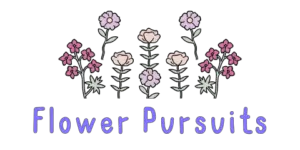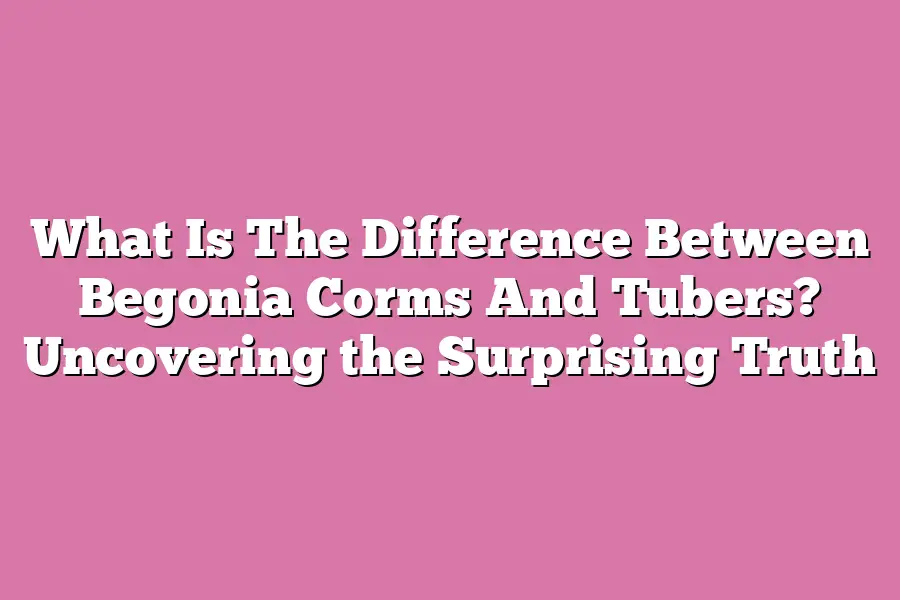Begonias produce both corms and tubers, but they serve different purposes. Corms are short, stout stems that resemble small potatoes and store nutrients for the plant during dormancy. Tubers, on the other hand, are swollen roots that also provide energy storage for the plant. While both types of structures can be used to propagate begonias, corms tend to produce new plants more readily than tubers.
As a seasoned plant enthusiast, I’ve always been fascinated by the intricacies of corms and tubers.
These underground storage organs are responsible for fueling the growth of countless plants, but did you know that they’re not just similar – they’re actually quite distinct?
In this blog post, we’ll delve into the surprising truth about what sets these two types apart, and how understanding their unique characteristics can revolutionize your Begonia care routine.
From the offsets that sprout from corms to the eyes that give rise to new growth on tubers, we’ll explore the anatomy of these remarkable structures and uncover the secrets to propagating, storing, and nurturing your favorite Begonias like a pro.
So, if you’re ready to take your plant parenting game to the next level, let’s get started!
Table of Contents
Anatomy of Corms and Tubers: Unpacking the Surprising Truth
As a plant enthusiast, I’m always excited to dive into the fascinating world of underground storage organs.
Today, we’re going to explore the difference between begonia corms and tubers – a topic that’s sure to delight both seasoned gardeners and curious newcomers alike!
What Are Corms?
Let’s start with the basics.
Corms are short, thickened stems that store energy for the plant during times of dormancy or periods when growth is slow.
These clever little structures allow plants like Crocus, Gladiolus, and Daffodil to survive harsh winters or dry spells by drawing upon stored nutrients.
Characteristics of Corms
So, what sets corms apart from other underground storage organs?
For starters, corms typically produce new growth from the top of the corm itself – a process known as “cormel” formation.
This means that the emerging shoots will sprout directly from the corm’s apex.
Another key characteristic is their remarkable ability to be stored for long periods before planting.
In fact, some corms can remain dormant for up to 3-5 years or more without losing their viability!
This makes them an excellent choice for gardeners who want to get a head start on the growing season or plan ahead for future harvests.
What Are Tubers?
Now that we’ve covered corms, let’s shift our attention to tubers.
Enlarged stems that store energy and nutrients for the plant, tubers are a staple in many gardens – think Potatoes, Sweet potatoes, and Begonias!
Characteristics of Tubers
So, what sets tubers apart from their cormy counterparts?
For one, tubers produce new growth from eyes or buds on the surface of the tuber itself.
This means that emerging shoots will sprout from small, raised areas called “eyes” or “lenticels.”
Another key characteristic is the relatively shorter storage period for tubers compared to corms.
While some tubers can be stored for up to a year or more, they generally don’t have the same level of dormancy as corms.
Begonia Tubers: The Surprising Truth
Now that we’ve covered the basics, let’s talk about Begonias specifically.
These gorgeous flowering plants are often grown for their vibrant blooms and attractive foliage – but did you know that their tubers can be stored for up to 6-12 months?
That’s a long time to keep those beautiful begonia flowers in storage!
By understanding the differences between corms and tubers, gardeners can make more informed decisions about which plants to choose, how to care for them, and when to harvest.
Whether you’re a seasoned green thumb or just starting out, this knowledge will give you a solid foundation for growing your own begonias – or any other plant that relies on these clever underground storage organs!
Key Differences Between Corms and Tubers in Begonia Care
As a begonia enthusiast, you might be wondering what lies beneath the surface of these beautiful plants.
Specifically, what’s the difference between corms and tubers?
Well, let me tell you – it’s not just about semantics!
Understanding the unique characteristics of each can mean the difference between success and failure in your begonia care routine.
Propagation: The Birth of New Life
When it comes to propagation, corms and tubers take two distinct approaches.
Corms are like the ultimate multi-taskers – they produce offsets (small plants) around their base, giving you a head start on growing new begonias.
It’s like having your own personal plant nursery built right into the mother plant!
On the other hand, tubers rely on eyes or buds to grow new shoots.
While both methods can be effective, corms seem to have an edge when it comes to producing multiple offspring at once.
Storage: The Long Game
Now that you know how begonias propagate, let’s talk about storage.
Both corms and tubers require specific conditions to maintain their viability – but for different reasons.
Corms can be stored for longer periods than tubers because they’re more resistant to drying out.
In fact, some begonia species can survive for up to a year in a dry state!
Tubers, on the other hand, are more sensitive to moisture levels and require consistent humidity to stay healthy.
Watering and Humidity: A Soggy Situation
Last but not least, let’s dive into watering and humidity.
You might be surprised to learn that corms tend to prefer drier conditions than tubers.
This is because they’re designed to survive in arid environments where water is scarce.
Tubers, by contrast, thrive in moister environments – think tropical rainforests!
When it comes to begonia care, understanding these differences can mean the difference between a soggy mess and a happy, healthy plant.
There you have it – the surprising truth about corms and tubers in begonia care.
By recognizing these key differences, you’ll be well on your way to becoming a master begonia cultivator.
Happy planting!
Case Studies: Begonia Varieties with Unique Characteristics
When it comes to understanding begonia corms and tubers, you might be wondering which varieties exhibit these characteristics.
Let me tell you, my friend, there are some fascinating examples out there that’ll make your plant-loving heart skip a beat.
Rhizomatous Begonias: The Corm-Like Crew
Meet the rhizomatous begonias – the OGs of corm-like behavior.
These guys produce new growth from the ends of stolons, which are basically underground stems that sprout new roots and shoots.
It’s like they’re saying, “Hey, I’m a corm!
Hear me roar!”
Take, for instance, Begonia obliqua, one of the most popular rhizomatous varieties.
Its stolons can grow up to 3 feet long, producing new growth at the tips.
It’s like a begonia version of a daisy chain – each stem connected to the next, creating an intricate network of foliage.
Angel Wing Begonias: The Tuber-Like Trio
Now, let’s talk about angel wing begonias (Begonia x hybrida).
These stunning plants exhibit tuber-like behavior by producing new growth from eyes on the surface of their tubers.
It’s like they’re saying, “Hey, I’m a potato – but way more stylish!”
Angel wing begonias are known for their beautiful, wing-shaped leaves and vibrant flowers.
But what’s fascinating is that they can produce multiple offsets around the base of their tubers, creating an entire mini-garden in one spot.
So there you have it – two amazing examples of begonia varieties with unique characteristics.
Whether you’re a corm enthusiast or a tuber aficionado (yes, those are things!), these plants will surely delight and inspire you to grow your own begonia collection.
Stay curious, keep learning, and remember: in the world of begonias, there’s always more to discover!
Final Thoughts
As I wrap up this exploration into the surprising truth about begonia corms and tubers, I’m left with a newfound appreciation for the intricacies of these fascinating plants.
By understanding the distinct characteristics of each – from propagation to storage – we can better care for our begonias and coax out their unique charms.
Whether you’re a seasoned gardener or just starting your begonia journey, remember that the key to success lies in recognizing the subtle differences between corms and tubers.
With this knowledge under your belt, you’ll be well on your way to cultivating stunning displays of foliage and blooms with these versatile plants.
So go ahead, get growing, and uncover the hidden wonders of the begonia world!

